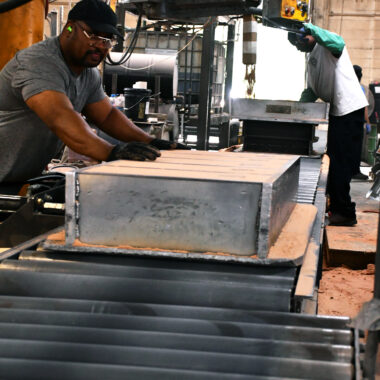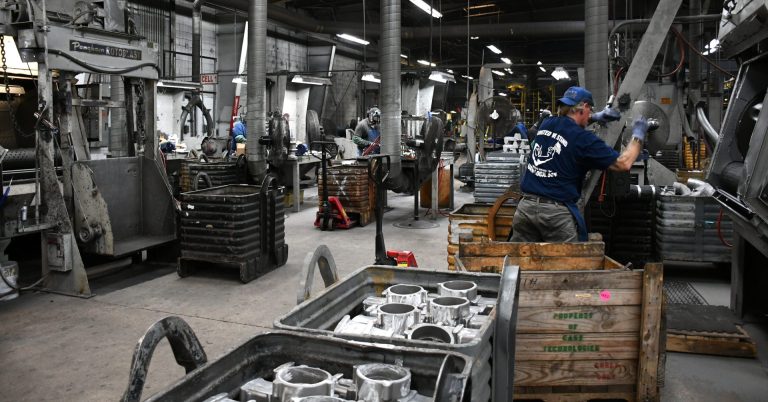Mastering Aluminum Casting: Proven Methods to Enhance Production Efficiency
Mastering Aluminum Casting: Proven Methods to Enhance Production Efficiency
Blog Article
Learning Aluminum Spreading: a Deep Dive Into the Numerous Strategies Available
Aluminum casting stands as a keystone of modern production processes, providing versatility and accuracy in creating practical parts and complex styles. As sectors significantly transform to light weight aluminum for its lightweight yet resilient residential or commercial properties, mastering the various casting techniques ends up being critical. From the typical approach of sand spreading to the complicated procedures of investment casting and pass away spreading, each strategy offers distinct difficulties and advantages. Understanding the nuances of these approaches is crucial for making certain the quality and effectiveness of the spreading process. In this expedition of aluminum spreading methods, we will clarify the details of each approach, offering understandings that can revolutionize your method to aluminum spreading.

Sand Casting Method Overview
The Sand Spreading method's versatility and extensive application make it a cornerstone in grasping light weight aluminum casting procedures. This method includes producing a mold and mildew from a blend of sand and a binder, such as clay, to form complex shapes for casting molten light weight aluminum. Sand casting is a popular option as a result of its fairly affordable, ease of alteration, and capacity to produce complicated geometries with high precision.
The process starts with the development of a pattern, usually made from wood or metal, which is pressed into the sand to create a mold and mildew cavity. Once the pattern is eliminated, the mold and mildew cavity is filled up with liquified aluminum, which strengthens to take the shape of the pattern. After cooling and solidification, the sand mold and mildew is damaged away, revealing the aluminum casting.
Sand casting is widely used in different sectors, including vehicle, aerospace, and production, due to its versatility in producing both tiny and huge aluminum components (aluminum casting). Its flexibility to elaborate styles and cost-effectiveness make it a preferred selection for lots of light weight aluminum spreading applications
Long-term Mold Casting Process Clarified
Exploring the intricacies of aluminum spreading, the Long-term Mold Casting procedure uses a polished technique for creating high-grade parts with accuracy and efficiency. Unlike sand spreading, permanent mold spreading makes use of a reusable mold and mildew generally made of steel or iron to form the liquified aluminum. The mold and mildew is preheated to a specific temperature to improve the flowability of the steel before putting. This procedure aids achieve a smoother surface finish and tighter resistances contrasted to sand spreading.
Permanent mold spreading can be categorized into two main kinds: gravity spreading and low-pressure spreading. Gravity casting includes pouring the liquified metal right into the mold making use of gravity, while low-pressure spreading makes use of low pressure to load the mold and mildew tooth cavity. Both approaches supply advantages in terms of decreasing porosity and boosting mechanical residential properties.
Pass Away Casting: Benefits and Negative Aspects
Grasping the complexities of die spreading includes understanding its distinct advantages and drawbacks in the world of light weight aluminum part manufacturing. Pass away casting deals a number of benefits that make it a preferred choice for generating light weight aluminum components. One vital advantage is the high-speed production capability of die spreading, enabling the automation of complicated shapes with limited resistances. Furthermore, pass away casting supplies outstanding dimensional accuracy and smooth surface finishes, reducing the demand for additional machining procedures. The procedure is additionally extremely repeatable, making sure constant high quality across big production runs.
Nonetheless, pass away spreading does come with its own collection of drawbacks. One major drawback is the high preliminary tooling expense associated with producing the dies used at the same time (aluminum casting). These mold and mildews can be pricey to generate, making pass away casting much less cost-effective for little production runs. Moreover, the procedure is not as flexible when it pertains to create modifications contrasted to other casting approaches like sand spreading. In spite of these limitations, the advantages of die spreading commonly surpass the negative aspects, making it a preferred option for many light weight aluminum casting applications.
Financial Investment Casting Benefits and applications
Structure on the advantages of die casting, investment spreading offers a versatile technique for generating detailed light weight aluminum elements with distinct advantages in different applications. Financial investment casting, also called lost-wax spreading, stands out in creating complicated shapes that would be challenging or difficult to achieve through other techniques. This method is widely utilized in sectors such as aerospace, auto, and fashion jewelry production.
One of the essential benefits of financial investment spreading is its capacity to create near-net shape components, reducing the demand for added machining and decreasing product waste. This results in cost savings and faster manufacturing times contrasted to standard machining processes. In addition, financial investment casting permits the production of get rid of exceptional surface area finishes and limited tolerances.
In the aerospace market, investment spreading is favored for its ability to create lightweight yet solid components crucial for aircraft performance. The automotive industry gain from financial investment casting for producing parts with high dimensional accuracy and detailed styles. In general, financial investment spreading provides a affordable and accurate remedy for producing complex light weight aluminum components across different sectors.

Lost Foam Spreading: Just How It Works
Lost foam click to find out more casting, also recognized as evaporative-pattern casting, is an approach for developing detailed steel components by making use of foam patterns that vaporize throughout the spreading process. When molten metal is poured into the mold, the foam evaporates due to the warm, leaving behind a cavity that is after that filled up by the metal.
One of the vital benefits of lost foam casting is its ability to produce intricate forms with elaborate information that may be challenging to attain with various other casting methods. Furthermore, the procedure can be cost-efficient as it eliminates the demand for cores and permits for the debt consolidation of several parts into a solitary part. It calls for careful control of the procedure criteria to ensure appropriate foam evaporation and metal circulation.
Conclusion
To conclude, mastering aluminum casting includes understanding and making use of various strategies such as sand spreading, long-term mold casting, die spreading, investment casting, and lost foam casting. Each technique has its own advantages and applications in the production process. By familiarizing oneself with these various techniques, manufacturers can pick one of the most appropriate spreading technique for their particular needs and needs, ultimately resulting in efficient and effective manufacturing of light weight aluminum components.
From the standard technique of sand spreading to the complex procedures of investment spreading and die spreading, each technique provides distinct challenges and benefits. In this expedition of light weight aluminum spreading techniques, we will certainly shed light on the intricacies of each technique, providing insights that could reinvent your strategy to light weight aluminum spreading.

Report this page